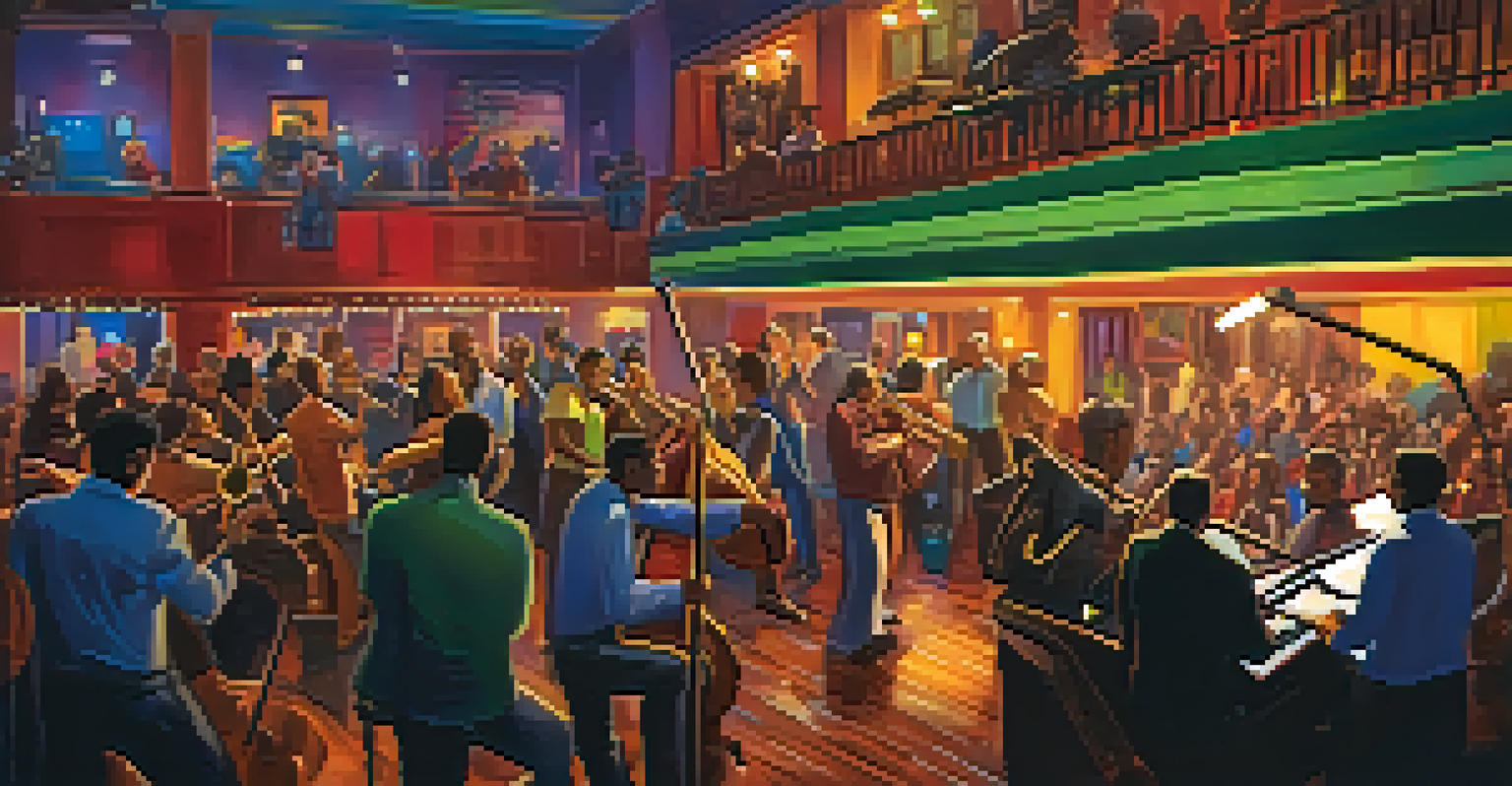Bossa Nova: A Fusion of Jazz and Brazilian Guitar Styles

Understanding Bossa Nova: A Brief Overview
Bossa Nova, which translates to 'new trend' in Portuguese, emerged in the 1950s in Brazil. This unique musical style blends samba rhythms with the harmonies of jazz, creating a sound that feels both breezy and sophisticated. It’s like taking a leisurely stroll on a sunlit beach, where every note feels as refreshing as the ocean breeze.
Bossa Nova is not just a musical genre; it is a way of life, a celebration of the beauty of simplicity.
The movement was largely shaped by talented artists such as João Gilberto and Tom Jobim, who brought their innovative sounds to life. Bossa Nova quickly captured the hearts of many, both in Brazil and around the world, thanks to its soft melodies and poetic lyrics. Imagine sipping a caipirinha while listening to a soothing Bossa Nova tune—pure bliss!
Today, Bossa Nova continues to influence various genres and artists, highlighting its lasting legacy. It's not just a musical style; it's an experience that evokes feelings of nostalgia and joy. As we dive deeper into its elements, you'll see how this fusion of jazz and Brazilian guitar styles creates something truly magical.
The Origins of Bossa Nova: Historical Context
Bossa Nova originated in the post-war era of Brazil, a time when the country was experiencing significant cultural changes. The music scene was vibrant, and musicians sought to create something fresh and modern. It was during this period that jazz began to enter Brazil, influencing local artists and sparking a creative revolution.

The beaches of Rio de Janeiro became the backdrop for this new wave of music, where young, affluent Brazilians mingled and shared their love for art and culture. This social environment played a crucial role in shaping Bossa Nova, giving it a sense of intimacy and relaxation. Picture a gathering of friends on a sandy beach, sharing stories and laughter while soft melodies fill the air—this is the essence of Bossa Nova.
Bossa Nova: A Unique Musical Blend
This genre combines samba rhythms with jazz harmonies, creating a sound that is both breezy and sophisticated.
As Bossa Nova gained popularity, it attracted international attention, further blending its Brazilian roots with global sounds. This cross-cultural exchange enriched the genre, allowing it to evolve while still honoring its origins. Understanding this historical context helps us appreciate the depth and beauty of Bossa Nova today.
Key Characteristics of Bossa Nova Music
Bossa Nova is characterized by its unique rhythm and harmony, which set it apart from other musical styles. The syncopated guitar patterns, often played softly, create a laid-back feel that invites listeners to relax. It's like a gentle wave lapping at the shore, bringing a sense of calm and tranquility.
The essence of Bossa Nova is in its subtlety, a gentle touch that evokes deep emotions.
Melodically, Bossa Nova often employs complex jazz chords, giving the music a rich and sophisticated sound. This harmonic structure, combined with soft vocals, creates an intimate atmosphere that draws listeners in. Imagine sitting in a cozy café, where the soft hum of Bossa Nova fills the space, making every moment feel special.
Additionally, the lyrics of Bossa Nova songs often reflect themes of love, longing, and nature. They paint vivid pictures that resonate with listeners, allowing them to connect emotionally with the music. This blend of rhythm, harmony, and lyrical depth is what makes Bossa Nova so enchanting.
The Impact of Jazz on Bossa Nova's Development
Jazz played a pivotal role in the development of Bossa Nova, introducing new musical elements that enriched the genre. Brazilian musicians were inspired by the improvisational nature of jazz, which encouraged them to explore their creativity. This influence is evident in the intricate guitar work and sophisticated chord progressions found in many Bossa Nova songs.
Furthermore, the interaction between Brazilian rhythms and jazz techniques created a unique fusion that captivated audiences. Musicians like Stan Getz helped popularize Bossa Nova in the United States, bridging the gap between these two rich musical traditions. Imagine the excitement of a jazz club filled with the sounds of samba-infused melodies—it's a celebration of cultural harmony.
Cultural Roots and Global Impact
Emerging from Brazil's vibrant post-war era, Bossa Nova has influenced various artists worldwide, bridging cultural divides.
As Bossa Nova continued to evolve, it incorporated various jazz styles, from cool jazz to modal jazz. This ongoing dialogue between the two genres has enriched Bossa Nova, making it a dynamic and ever-evolving art form. The symbiosis of jazz and Brazilian music showcases the beauty of cross-cultural collaboration.
Influential Artists Who Shaped Bossa Nova
Several artists have played a significant role in shaping the sound and popularity of Bossa Nova. João Gilberto, often regarded as the father of Bossa Nova, revolutionized guitar playing with his distinctive technique and vocal style. His album 'Chega de Saudade' is often considered the cornerstone of the genre, inviting listeners to experience the essence of Bossa Nova.
Tom Jobim, another key figure, contributed timeless compositions that have become classics within the genre. His work, including songs like 'The Girl from Ipanema,' not only showcases the beauty of Bossa Nova but also highlights its global appeal. Picture a warm summer evening, with Jobim's melodies drifting through the air—it's a moment that lingers in the heart.
Other influential artists, such as Vinicius de Moraes and Elis Regina, further enriched the genre with their unique styles and interpretations. Together, these musicians created a tapestry of sound that continues to inspire new generations of artists. Their legacy lives on, reminding us of the power of music to transcend boundaries.
The Global Influence of Bossa Nova
Bossa Nova has not only captivated audiences in Brazil but has also made a significant impact on global music. Its soothing melodies and intricate rhythms have found their way into the hearts of listeners worldwide. Many contemporary artists draw inspiration from Bossa Nova, incorporating its elements into various genres like pop, jazz, and even electronic music.
The genre's international appeal is evident in the collaborations between Bossa Nova musicians and artists from different backgrounds. For instance, the collaboration between Brazilian musicians and American jazz artists has led to the creation of beautiful cross-cultural works that celebrate their shared love for music. Imagine a vibrant fusion of styles coming together, creating a new sound that resonates with diverse audiences.
Contemporary Revival of Bossa Nova
Young musicians are breathing new life into Bossa Nova, blending traditional elements with modern influences to captivate new audiences.
Moreover, Bossa Nova has influenced countless film soundtracks, enhancing the emotional depth of cinematic storytelling. Its timeless quality allows it to remain relevant, continuing to touch the hearts of new listeners. The global influence of Bossa Nova is a testament to the power of music to connect people across cultures.
Bossa Nova Today: A Contemporary Revival
In recent years, there has been a resurgence of interest in Bossa Nova, particularly among younger generations. This revival has led to a new wave of artists who are blending traditional Bossa Nova with modern sounds and influences. It's like breathing new life into an old classic, creating something fresh and exciting while honoring its roots.
Social media and streaming platforms have played a significant role in this revival, allowing Bossa Nova to reach a wider audience. Young musicians are experimenting with the genre, incorporating elements of hip-hop, electronic music, and even indie pop. Imagine discovering a new artist who takes the essence of Bossa Nova and infuses it with contemporary flair—it's a delightful surprise!

This contemporary revival not only keeps Bossa Nova alive but also introduces its beauty to new listeners. As the genre continues to evolve, it remains a symbol of cultural exchange and creativity. The future of Bossa Nova is bright, as it embraces innovation while staying true to its enchanting roots.